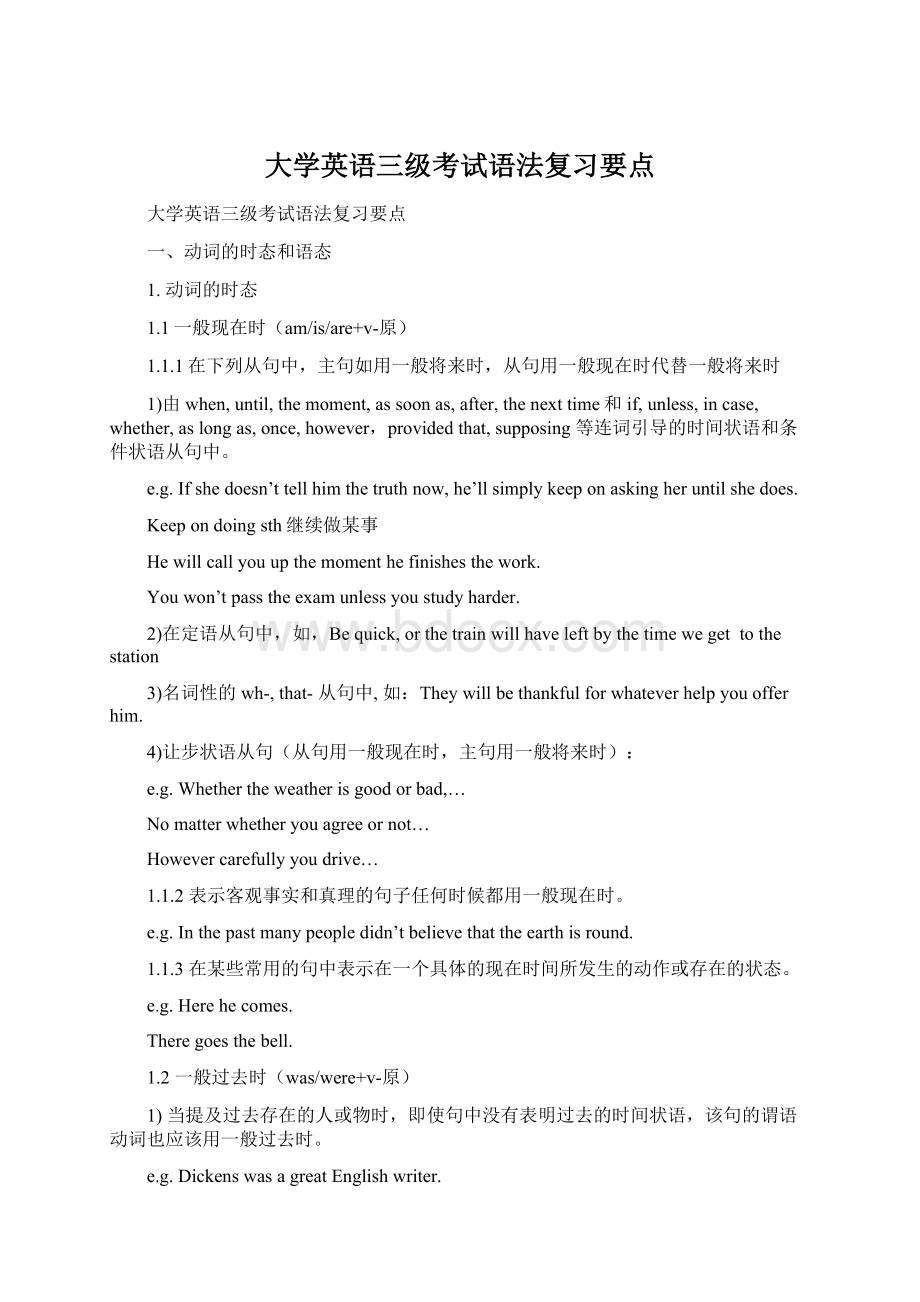大学英语三级考试语法复习要点.docx
《大学英语三级考试语法复习要点.docx》由会员分享,可在线阅读,更多相关《大学英语三级考试语法复习要点.docx(50页珍藏版)》请在冰豆网上搜索。

大学英语三级考试语法复习要点
大学英语三级考试语法复习要点
一、动词的时态和语态
1.动词的时态
1.1一般现在时(am/is/are+v-原)
1.1.1在下列从句中,主句如用一般将来时,从句用一般现在时代替一般将来时
1)由when,until,themoment,assoonas,after,thenexttime和if,unless,incase,whether,aslongas,once,however,providedthat,supposing等连词引导的时间状语和条件状语从句中。
e.g.Ifshedoesn’ttellhimthetruthnow,he’llsimplykeeponaskingheruntilshedoes.
Keepondoingsth继续做某事
Hewillcallyouupthemomenthefinishesthework.
Youwon’tpasstheexamunlessyoustudyharder.
2)在定语从句中,如,Bequick,orthetrainwillhaveleftbythetimewegettothestation
3)名词性的wh-,that-从句中,如:
Theywillbethankfulforwhateverhelpyouofferhim.
4)让步状语从句(从句用一般现在时,主句用一般将来时):
e.g.Whethertheweatherisgoodorbad,…
Nomatterwhetheryouagreeornot…
Howevercarefullyyoudrive…
1.1.2表示客观事实和真理的句子任何时候都用一般现在时。
e.g.Inthepastmanypeopledidn’tbelievethattheearthisround.
1.1.3在某些常用的句中表示在一个具体的现在时间所发生的动作或存在的状态。
e.g.Herehecomes.
Theregoesthebell.
1.2一般过去时(was/were+v-原)
1)当提及过去存在的人或物时,即使句中没有表明过去的时间状语,该句的谓语动词也应该用一般过去时。
e.g.DickenswasagreatEnglishwriter.
Whendidyouwritethestory?
2)在表示时间或条件的状语从句中代替过去将来时。
e.g.Theysaidtheywouldletusknowiftheyheardanynewsabouthim.
IdecidedtogotothelibraryassoonasIfinishedwhatIwasdoing.
1.3一般将来时:
表示将来打算进行或期待发生的动作或存在的状态。
表示将来的谓语结构有:
shall/willdo
begoingtodo
beabouttodo:
表示动作“正要”,“刚要”发生,不与表示将来的时间状语连用。
betodo:
表示按“日程”将要发生的动作,或用来征询意见。
bedoing(come,go,arrive,drive,fly,leave,start,plan)
willbedoing:
常表示预计即将发生或势必发生的动作,它含有已经安排好的意思。
e.g.Wemusthurry.Thefilmisabouttostart.
Georgeisarrivingonthefouro’clocktrainthisafternoon.
Thereistobeatestattheendofthisterm.
Arewetogonow?
Don’tworry.IexpectI’llbeseeinghimtomorrow.ThenIcantellhimaboutit.
试比较:
Iwillbeseeinghimaboutittomorrow.
I’llseehimaboutittomorrow.(末事先安排好)
1.4现在进行时 (bedoing)
该时态可以同频度副词,如:
always,forever,constantly连用,带有情感色彩,如赞扬或厌烦等。
e.g.Heisalwaysaskingthesamequestion.
试比较:
Heisalwayscominglate.
Healwayscomeslate.
1.5现在完成时(have/has+done)
1)在含有thefirst/secondtime/superlativedegree+n句型中,通常用现在完成时
e.g.Thisisthefirsttimetheyhavetraveledbyair.
ThisisthemostinterestingnovelIhaveeverread.
2)由连词since引出状语从句时,主句一般都用现在完成时,有时用现在完成进行时,从句用一般过去时。
句型:
S+have/hasV-ed2/beenV-ingsinces+V-ed1
e.g.Ihavenotheardfromhersincewegraduatedfromuniversity.
Hehasbeenworkinginthisschoolsincehecamehere.
3)用于时间状语从句或条件状语从句表示将来完成的动作。
e.g.IwillreturnyourbookonMondayifIhavereadit..具体的某一天用on
IwillletyouknowafterIhavetalkedwithhim.
Thestudentswillgohomeassoonastheyhavefinishedtheexams.
Checkitoutwhenyouhavefinishedit.
4)现在完成时经常与不确定的过去时间状语连用,如:
already,just,yet,before,recently,lately等;也可同表示频度的时间状语连用,如:
often,ever,never,twice,等;还可同表示一段时间的状语连用,如:
for,since,in(for)thelast/pasttenyears,thesetendays,uptonow,sofar等。
5)go,come,return,buy,become,join,borrow等瞬间动词不能和表示延续的时间状语连用。
要表示有关的意思时应该用have的完成时或be的完成时。
e.g.Theyhavebeenbackformorethanamonth.
不能说:
Theyhavecomebackformorethanamonth.
Hehashadthebikefortwoyears.
不能说:
Hehasboughtthebikefortwoyears.
1.6现在完成进行时(havebeendoing)
强调一个动作从过去开始一直持续到现在,没有中断过,并将继续下去。
e.g.Hehasbeendoinghishomeworkallthemorningbuthasn’tfinishedityet.
1.7过去完成时
这是一个相对的时态,只有与过去时或过去某个动作相比较时才能用。
1)在含有when,before,after,until,assoonas等引起的时间状语的主从句中,若主从句谓语均表过去的动作,则动作在先的用过去完成时。
e.g.WhenIhadfinishedmyhomework,Iwentoutforawalk.
TheyhadleftbeforeIreturned.
2)在含有hardly,scarcely,barely,nosooner等词的主从复合句中,从句谓语一般用过去完成时,主句用一般过去时。
e.g.NosoonerhadIarrivedattheschoolthanthebellrang.
Hardlyhadhefinishedhisspeechwhentheaudiencestartedcheering.
3)含有bytheendof+过去时间的介词短语的句子中,谓语动词应用过去完成时。
e.g.Shehadfinishedherdesignbytheendoflastmonth.
4)有些动词,如intend,hope,plan,mean,think等的过去完成时表示过去未曾实现的希望、打算或意图。
e.g.Ihadhopedthatshewouldanswermyletter.
Shehadintendedtogotothecinemalastnight,butshewasbusythen.
1.8过去完成进行时
表示过去某时或某动作之前的动作或状态一直持续到过去某个时候,没有中断过。
e.g.Hehadbeenworkingintheofficefortwoyearsbeforeshegotaraise.
1.9将来完成时:
表示将来某时之前已完成的动作。
e.g.Bytheendofthismonth,wesurelywillhavefoundasatisfactorysolutiontotheproblem.
Theconferencewillhavelastedafullweekbythetimeitends.
2.被动语态
在不知道或没有必要说明动作的执行者是谁时,或者为了突出或强调动作承受者时,就用被动语态。
e.g.Mybikewasstolenlastnight.
Theplanhasbeenmade.
结构:
be+V-ed2
2.1各种时态的被动语态
主动语态
被动语态
一般现在时
V(s)
is/am/are+V-ed2
一般过去时
V-ed1
was/were+V-ed2
一般将来时
shall/will+V
shall/will+be+V-ed2
现在完成时
have/has+V-ed2
have/has+been+V-ed2
过去完成时
had+V-ed2
had+beenV-ed2
现在进行时
Is/am/are+V-ing
is/am/are+being+V-ed2
过去进行时
was/were+V-ing
was/were+being+V-ed2
2.2含有情态动词的被动语态结构:
情态动词+be+V-ed2
e.g.Allthatcanbedonehasbeendone.
Theworkmustbedoneatonce.
3.时态的呼应
在主从复合句中,主要是在宾语从句中,时态常受主句谓语动词时态的影响,从句的时态要做一些必要的调整,这种现象叫时态的呼应。
关于主、从句时态的呼应,应注意以下两点:
1)如果主句的谓语动词是现在时或将来时,宾语从句的谓语动词可以是各种时态。
e.g.Idon’tapproveofwhathedid.
Willyoutellushowyoumanagedtoovercomethedifficulties?
2)如果主句的谓语动词是过去时态,从句应该用相应的过去时态,但如果从句表示一个客观真理,则从句用一般现在时。
e.g.thattheteacherwasintheclassroom..
thattheteacherwastalkingwiththestudents.
Shetoldmethattheteacherhadbeenintheclassroomforhalfanhour.
thatshewasbornin1980.
thattheteacherwouldleavetheclassroomsoon.
thattheearthgoesroundthesun.
4.情态动词+完成体
1)情态动词为现在时,表示对过去事情的推测,把握性大。
must+have+V-ed2一定已经(把握性大的推测)
can+have+V-ed2可能已经(把握性较弱)
may+have+V-ed2也许已经(把握性最弱)
cannot+have+V-ed2一定没有(否定推测)
2)情态动词”may,can”的过去时,表示对过去事情的推测,可能性小点;或表示本来可以完成或发生而实际并末完成或发生的事情。
could+have+V-ed2表示可能已经或本来可以完成,但事实上并没有实现的事情。
might+have+V-ed2表示也许已经,或者对本来也许发生而实际并未发生的事情表示“感叹”或“遗憾”,并含有“劝告”、“责备”的语气。
should/oughtto+have+V-ed2本来应该做而实际并未做
shouldnot/oughtn’ttohaveV-ed2本来不应该做而实际做了的
needn’thave+V-ed2表示本来不必要做的事情已经做了。
didn’tneed+toV表示没有必要做,实际上也没有做。
e.g.Youcan’thaveseenherintheofficelastFriday;she’sbeenoutoftownfortwoweeks.
Withallthisworkonhand,heshouldn’thavegonetothecinemalastnight
Youneedn’thavedoneallthosecalculations!
Wehaveacomputertodothatsortofthing.
Hemay/mighthaveheardthenewsyesterday.
Thedictionaryhasdisappeared.Whocouldhavetakenit?
二、非谓语动词
非谓语动词包括不定式、动名词、和分词三种形式,它们的功能如下:
主语
表语
宾语
宾补
定语
状语
否定式
逻辑主语
不定式
not+toV
for/ofsb.
分词
not+V--ing/V-ed
动名词
not+V-ing
sb’s
1.不定式。
表示未来的、具体的、一次性的行为。
1.1作主语
句型:
ToVis+adj/n.
Itis+adj/n+.toV
e.g.Itisimportant(hard,easy,necessary)forsbtodosth.
Itiskind(foolish,nice,wise,unwise,clever,silly,wrong,right,stupid,careless,considerate,rude,impolite,naughty)ofyoutodosth.
Itisapity(ashame,anhonour,apleasure)todosth.
Ittakes/tooksb.sometimetodosth.
Totalkwithhimisagreatpleasure.
Itisagreatpleasuretotalkwithhim.
ItisnecessaryforustolearnEnglishwell.
Itisverythoughtfulofyoutohavearrangedallthis.
1.2作表语,表示具体的、将来的动作。
句型:
S+系动词+toV
e.g.Hisjobtodayistocleantheroom.
Thebestwaytodointhepresentsituationiswaitandsee.(当主语部分含有do的某种形式时,to可省)
试比较:
Herwishistobecomeateacher.
Iamtogoonwiththework.
1.3作宾语。
句型:
S+Vt+toV
1)下列动词后只能用不定式作宾语:
hope,wish,expect,want,offer,promise,refuse,decide,pretend,afford,agree,attempt,fail,intend,learn,manage,plan
e.g.Weexpecttoorganizeayouthclub.
Hepromisedtocomebackontime.
2)在show,tell,teach,know,findout,decide,wonder,advise,discuss等动词后,常用一个带wh-words的不定式作宾语/宾补,构成V+wh-words+toV…
e.g.Showmehowtodoit.
Idon’tknowwheretoputit.
3)若作宾语的不定式有补足语时,先用先行词it作形式宾语而将正直的宾语不定式后移置补足语之后。
句型:
S+Vt(think,consider,find,make)+it+O.C(adj/n)+todo
e.g.IfinditdifficulttofollowtheprofessorforIhaven’tpreparedfortheclass.
WethinkitnecessarytolearnEnglishwell.
Ifinditapleasuretotalkwithyou.
1.4作宾补。
1)不定式在句中作宾补时,可带不定式符号to,也可不带。
下列动词:
see,watch,notice,observe,hear,feel,listento,lookat,make,have,let等后的不定式作宾补时,to必须省去。
句型:
Vt+O+toVVt+O+V
e.g.Hewantedyoutocallhimbackatnoon.
Thecoachmadetheplayerspractiseeveryday.
Idon’tnoticeyouenter.
但这种句子变为被动语态时,“to”必须还原。
e.g.Theplayersweremadetopractiseeveryday.
2)besaid/bereported/beknown/bethought/bebelieved/seem/happen/appear/prove等常以toV或tobe作主补。
e.g.Heissaidtobefromapoorpeasantfamily.
Heissaidtohavegoneabroad.
3)下列句型中不定式不带”to”
hadbetter+V/wouldrather+V…than..+V/do…except/but+V/hadrather+V/
cannotbut+V
e.g.Hesaidhewoulddoanythingexceptcook.
Hecandonothingbutwait.
1.5作定语。
不定式作定语一般放在被修饰词后,表示一个将来的动作。
句型:
n.+toV
1)不定式与其所修饰的词之间往往有动宾关系。
如果该不定式是不及物动词,其后应有必要的介词。
e.g.Ihavealotofquestionstoask.
Roberthasalargefamilytosupport
Givemeasheetofpapertowriteon.
Thereisnothingtoworryabout.
试比较:
Doyouhaveanythingtobetakentoyourson?
Doyouhaveanythingtodo?
2)有些名词后常跟不定式作定语。
此类常见名词有:
way,right,chance,ambition,ability,attempt,promise,tendency,wish,desire,decision等。
e.g.Hisattempttosolvetheproblemturnedouttobeafailure.
Isthatthebestwaytosolvetheproblem?
3)only,last,next以及形容词最高级和序数词修饰名词时,常用不定式。
e.g.Heisalwaysthefirstonetocometoschool.
Idon’tthinkheisthebestmantodothejob.
1.6不定式作状语
1)不定式后置表示原因,不定式说明产生该形容词表示的情绪的原因,不定式修饰某些形容词表示范围、情况,这类形容词有:
clever,comfortable,difficult,easy,foolish,right,wrong等。
句型:
be+adj/V-ed2+toV
e.g.Thequestionisdifficulttoanswer.
Aliceiseasytogetalongwith.(不